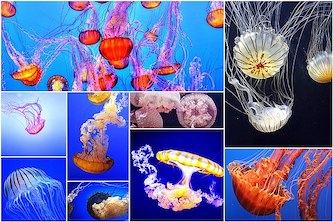The Marine Conservation Society has found that there were 32% more jellyfish sightings in UK waters and on beaches in the past year. The most commonly seen jellyfish were the large barrel jellyfish, but they also spotted rarer warm-water crystal jellyfish. This increase in jellyfish is because of climate change, which has caused a marine heatwave and raised UK water temperatures by 3-4C in June.
The Marine Conservation Society’s yearly report is based on reports from the public through an online form or app. From October 2022 to September 2023, jellyfish sightings went up by 32%, with most sightings happening on the west coasts of the UK, especially in Cornwall and Wales. The survey also reported large groups of more than 100 jellyfish.
The increase in jellyfish sightings might be part of a 20-year cycle, but it also shows how climate change is affecting marine life. Dr. Abigail McQuatters-Gollop, a plankton expert at the University of Plymouth, noticed a lot of jellyfish this year, including the crystal jellyfish, which isn’t usually found in UK waters. The warmer waters from climate change might be making more jellyfish in the UK.
The long-term effects of warmer UK seas are expected to change the country’s fish stocks as the food that current fish species eat will change. Also, the survey found more turtle sightings, with four of them being leatherback turtles. People are told not to touch jellyfish or turtles and to tell the Marine Conservation Society if they see any. In conclusion, the increase in jellyfish sightings in UK waters shows how climate change is affecting marine life. The warming of UK seas is making it easier for jellyfish to grow, and we need more research to understand what this means for the future.
Original news source: Boom in unusual jellyfish spotted in UK waters (BBC)
Listen
Slow
Normal
Fast
Group or Classroom Activities
Warm-up Activities:
– News Summary
Instructions: Students work in pairs to summarize the article in their own words. They should aim to condense the article into four sentences that capture the main points. Afterward, each pair presents their summary to the class, and the class discusses any differing details that come up in the summaries.
– Opinion Poll
Instructions: Create a series of statements related to the article about jellyfish sightings and climate change. For example: “The increase in jellyfish is a significant indicator of climate change,” or “Marine heatwaves are the most concerning effect of climate change on marine life.” Students move to different areas of the room to show how strongly they agree or disagree with each statement. Then, have students discuss their positions in small groups.
– Word Association
Instructions: Write the word “jellyfish” on the board and ask students to call out words or phrases they associate with this word after reading the article. Expand the web of associations with related terms such as “climate change,” “marine heatwave,” and “marine conservation.” Discuss the associations and how they interlink, reflecting on the content of the article.
– Vocabulary Pictionary
Instructions: Prepare a list of key vocabulary from the article, such as “conservation,” “sightings,” “marine,” “species,” and “ecosystem.” Divide the class into two teams. Members from each team take turns drawing a word for their team to guess. Use a timer to add pressure, and award points for correct guesses.
– Future Predictions
Instructions: Based on the article, ask students to work in small groups to predict the future of UK marine life and the global implications if the current trends continue. Each group should present their predictions, and then the class can discuss the likelihood and potential impacts of these predictions, referencing the article’s content to support their arguments.
Comprehension Questions:
1. What percentage increase in jellyfish sightings was reported in the UK over the past year?
2. Which type of jellyfish was most commonly seen in the UK waters and beaches?
3. What are the reasons behind the increase in jellyfish sightings, according to the article?
4. How does the Marine Conservation Society collect data for their yearly report on jellyfish sightings?
5. During which months did the Marine Conservation Society record the increased jellyfish sightings?
6. Where in the UK were the most jellyfish sightings reported?
7. What other marine creature has been seen more frequently, as mentioned in the survey?
8. What advice does the article give to people who encounter jellyfish or turtles?
Go to answers ⇩
Listen and Fill in the Gaps:
The Marine Conservation Society has found that there were 32% more (1)______ sightings in UK (2)______ and on beaches in the past year. The most commonly seen jellyfish were the large barrel jellyfish, but they also spotted rarer warm-water (3)______ jellyfish. This increase in jellyfish is because of climate change, which has caused a marine heatwave and (4)______ UK water temperatures by 3-4C in June.
The Marine Conservation Society’s yearly report is based on reports from the public through an online form or app. From October 2022 to September 2023, jellyfish sightings went up by 32%, with most sightings happening on the west coasts of the UK, especially in Cornwall and Wales. The (5)______ also reported large groups of more than 100 jellyfish.
The increase in jellyfish sightings might be part of a 20-year cycle, but it also (6)______ how (7)______ change is affecting (8)______ life. Dr. Abigail McQuatters-Gollop, a plankton (9)______ at the University of Plymouth, noticed a lot of jellyfish this year, including the crystal jellyfish, which isn’t usually (10)______ in UK waters. The warmer waters from climate (11)______ might be making more jellyfish in the UK.
The long-term effects of warmer UK seas are expected to change the country’s fish (12)______ as the food that current fish species eat will change. Also, the survey found more turtle sightings, with four of them being leatherback (13)______. (14)______ are told not to touch jellyfish or turtles and to tell the Marine Conservation Society if they see any. In (15)______, the increase in jellyfish sightings in UK waters shows how climate change is affecting marine life. The warming of UK seas is making it easier for jellyfish to grow, and we need more research to understand what this (16)______ for the future.
Go to answers ⇩
Discussion Questions:
Students can ask a partner these questions, or discuss them as a group.
1. What is climate change and how do you think it affects our oceans?
2. Have you ever seen a jellyfish in person? How did you feel about it?
3. Do you think it’s a good idea for people to report jellyfish sightings? Why or why not?
4. How would you feel if you found a rare animal in your local area?
5. What kind of wildlife is common where you live? Do you like seeing them?
6. Do you think marine heatwaves are a serious problem? Why or why not?
7. Have you ever used an app to report something about nature? If so, what was it?
8. How do you think an increase in jellyfish might affect other sea creatures?
9. What is a marine conservation society, and why do you think their work is important?
10. Do you think the world is doing enough to fight climate change? Why or why not?
11. If you saw a turtle on the beach, what would you do?
12. How do you think changes in the sea temperature can affect the fish we eat?
13. What do you think could be done to protect marine life from climate change?
14. Do you think there are any benefits to having more jellyfish in the sea? Why or why not?
15. Why do you think it’s important for scientists to study changes in marine life?
Individual Activities
Vocabulary Meanings:
Match each word to its meaning.
Words:
1. jellyfish
2. sightings
3. climate
4. survey
5. expert
6. effects
7. leatherback
8. future
Meanings:
(a) A type of sea creature with stinging tentacles
(b) Instances of seeing something, like jellyfish in the water
(c) The changes that happen as a result of something
(d) A type of sea turtle with a leathery shell
(e) The time that is still to come, or what will happen later
(f) A person with a high level of knowledge in a particular subject
(g) The long-term patterns in the weather of a place
(h) A study to gather information about a specific topic
Go to answers ⇩
Multiple Choice Questions:
1. What caused the increase in jellyfish sightings in UK waters?
(a) Pollution
(b) Overfishing
(c) Ocean currents
(d) Climate change
2. Which jellyfish species was most commonly seen in the UK waters?
(a) Large barrel jellyfish
(b) Crystal jellyfish
(c) Lion’s mane jellyfish
(d) Moon jellyfish
3. How much did jellyfish sightings increase by in the past year?
(a) 20%
(b) 32%
(c) 45%
(d) 50%
4. Where were most jellyfish sightings reported in the UK?
(a) East coasts, especially in Norfolk and Suffolk
(b) Northern coasts, especially in Scotland
(c) West coasts, especially in Cornwall and Wales
(d) Southern coasts, especially in Devon and Dorset
5. Who noticed the increase in jellyfish sightings this year?
(a) A marine biologist from France
(b) A fisherman from Cornwall
(c) A scuba diver from Wales
(d) Dr. Abigail McQuatters-Gollop
6. What might the warmer UK waters from climate change lead to?
(a) Changes in fish stocks
(b) Increase in coral reefs
(c) Decrease in seaweed
(d) More shark sightings
7. What other marine animal sightings increased along with jellyfish?
(a) Dolphins
(b) Turtles
(c) Seals
(d) Penguins
8. What are people advised to do if they see jellyfish or turtles?
(a) Take them home as pets
(b) Try to move them to a different location
(c) Not to touch them and inform the Marine Conservation Society
(d) Ignore them and continue swimming
Go to answers ⇩
True or False Questions:
1. Climate change has caused a marine heatwave, raising UK water temperatures by 3-4C in June, leading to the increase in jellyfish.
2. The report is based on public reports through an online form or app from October 2022 to September 2023.
3. Most jellyfish sightings happened on the east coasts of the UK, especially in Kent and Suffolk, with some reports of large groups of less than 100 jellyfish.
4. The short-term effects of warmer UK seas are not expected to change the country’s fish stocks, and there have been no turtle sightings, including leatherback turtles.
5. The Marine Conservation Society reported a 32% increase in jellyfish sightings in UK waters and on beaches in the past year.
6. The most rarely seen jellyfish were small barrel jellyfish, but they also spotted common cold-water crystal jellyfish.
7. The increase in jellyfish sightings might be part of a 20-year cycle and is also a result of climate change affecting marine life.
8. The colder waters from climate change might be making fewer jellyfish in the UK.
Go to answers ⇩
Write a Summary:
Write a summary of this news article in two sentences.
Check your writing now with the best free AI for English writing!
Writing Questions:
Answer the following questions. Write as much as you can for each answer.
Check your answers with our free English writing assistant!
1. According to the Marine Conservation Society, by what percentage have jellyfish sightings increased in the UK?
2. What are the names of the two types of jellyfish mentioned in the article, and which one is less common?
3. How does the article explain the rise in jellyfish numbers in UK waters?
4. What method does the Marine Conservation Society use to collect data on jellyfish sightings?
5. What advice does the article give to people who encounter jellyfish or turtles?
Answers
Comprehension Question Answers:
1. What percentage increase in jellyfish sightings was reported in the UK over the past year?
There was a 32% increase in jellyfish sightings in the UK over the past year.
2. Which type of jellyfish was most commonly seen in the UK waters and beaches?
The large barrel jellyfish was the most commonly seen type in UK waters and beaches.
3. What are the reasons behind the increase in jellyfish sightings, according to the article?
The increase in jellyfish sightings is due to climate change, which has caused a marine heatwave and raised UK water temperatures by 3-4C in June.
4. How does the Marine Conservation Society collect data for their yearly report on jellyfish sightings?
The Marine Conservation Society collects data through reports from the public via an online form or app.
5. During which months did the Marine Conservation Society record the increased jellyfish sightings?
The increased jellyfish sightings were recorded from October 2022 to September 2023.
6. Where in the UK were the most jellyfish sightings reported?
The most jellyfish sightings were reported on the west coasts of the UK, especially in Cornwall and Wales.
7. What other marine creature has been seen more frequently, as mentioned in the survey?
More turtle sightings were mentioned in the survey, including four leatherback turtles.
8. What advice does the article give to people who encounter jellyfish or turtles?
The article advises people not to touch jellyfish or turtles and to report any sightings to the Marine Conservation Society.
Go back to questions ⇧
Listen and Fill in the Gaps Answers:
(1) jellyfish
(2) waters
(3) crystal
(4) raised
(5) survey
(6) shows
(7) climate
(8) marine
(9) expert
(10) found
(11) change
(12) stocks
(13) turtles
(14) People
(15) conclusion
(16) means
Go back to questions ⇧
Vocabulary Meanings Answers:
1. jellyfish
Answer: (a) A type of sea creature with stinging tentacles
2. sightings
Answer: (b) Instances of seeing something, like jellyfish in the water
3. climate
Answer: (g) The long-term patterns in the weather of a place
4. survey
Answer: (h) A study to gather information about a specific topic
5. expert
Answer: (f) A person with a high level of knowledge in a particular subject
6. effects
Answer: (c) The changes that happen as a result of something
7. leatherback
Answer: (d) A type of sea turtle with a leathery shell
8. future
Answer: (e) The time that is still to come, or what will happen later
Go back to questions ⇧
Multiple Choice Answers:
1. What caused the increase in jellyfish sightings in UK waters?
Answer: (d) Climate change
2. Which jellyfish species was most commonly seen in the UK waters?
Answer: (a) Large barrel jellyfish
3. How much did jellyfish sightings increase by in the past year?
Answer: (b) 32%
4. Where were most jellyfish sightings reported in the UK?
Answer: (c) West coasts, especially in Cornwall and Wales
5. Who noticed the increase in jellyfish sightings this year?
Answer: (d) Dr. Abigail McQuatters-Gollop
6. What might the warmer UK waters from climate change lead to?
Answer: (a) Changes in fish stocks
7. What other marine animal sightings increased along with jellyfish?
Answer: (b) Turtles
8. What are people advised to do if they see jellyfish or turtles?
Answer: (c) Not to touch them and inform the Marine Conservation Society
Go back to questions ⇧
True or False Answers:
1. Climate change has caused a marine heatwave, raising UK water temperatures by 3-4C in June, leading to the increase in jellyfish. (Answer: True)
2. The report is based on public reports through an online form or app from October 2022 to September 2023. (Answer: True)
3. Most jellyfish sightings happened on the east coasts of the UK, especially in Kent and Suffolk, with some reports of large groups of less than 100 jellyfish. (Answer: False)
4. The short-term effects of warmer UK seas are not expected to change the country’s fish stocks, and there have been no turtle sightings, including leatherback turtles. (Answer: False)
5. The Marine Conservation Society reported a 32% increase in jellyfish sightings in UK waters and on beaches in the past year. (Answer: True)
6. The most rarely seen jellyfish were small barrel jellyfish, but they also spotted common cold-water crystal jellyfish. (Answer: False)
7. The increase in jellyfish sightings might be part of a 20-year cycle and is also a result of climate change affecting marine life. (Answer: True)
8. The colder waters from climate change might be making fewer jellyfish in the UK. (Answer: False)
Go back to questions ⇧













